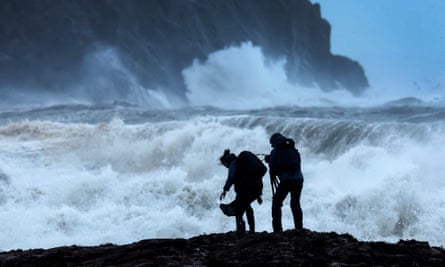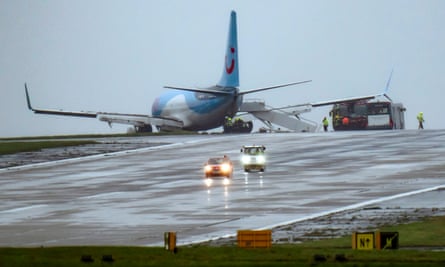Second ‘danger to life’ warning issued as Storm Babet continues to batter UK
Storm Babet is posing a “risk to life” as it continues to batter parts of the UK, with with three sever flood warnings issued for the River Derwent in Derbyshire.
A rare second “danger to life” red warning is also in place for parts of eastern Scotland.
More than 100 people have been rescued from flooded areas, dozens of people have spent the night in emergency accommodation and about 4,000 people across the UK are still without power.
Flooding is continuing and the Environment Agency has put three severe flood warnings in place around the River Derwent in Derbyshire, meaning deep and fast flowing water carries a significant risk of death or serious injury. Areas most at risk are the Derby, Water Treatment Works. There is also flooding in Derby city centre.
The Met Office warned people to expect “exceptional” amounts of heavy and persistent rainfall, deep and fast-flowing floodwater, dangerous driving conditions and loss of power on Saturday.
Amber warnings for rain and possible flooding are also in place for north-east Scotland and gales in excess of 60 to 70mph are expected across eastern Scotland and north-east England, with a yellow warning for wind in place until noon.
“Unfortunately, it is clear we have not seen the last of this storm,” said Scotland’s first minister, Humza Yousaf.

Three people died on Friday in the storm and Leeds Bradford airport had to be closed after a passenger plane that tried to land in high winds had to be evacuated after it skidded off the runway. The airportwas set to reopen at 11am on Saturday.
Across England, there were more than 353 flood warnings for parts of the north-east, Yorkshire, the north-west, East Anglia, the south-west and the Midlands. The focus of the torrential rainfall is expected to move back northwards on Saturday over eastern and northern Scotland – where some places have already seen about a month and a half’s worth of rain during the storm, the Met Office said.
Pascal Lardet, from the Scottish Environment Protection Agency, told BBC Radio 4’s Today programme: “After the exceptional rainfall recorded since Thursday morning, further rain is forecast to affect flooded areas across the region that has been mostly affected – across Tayside, Angus and Aberdeenshire.
“So there will be a second peak on some of the large rivers that we are monitoring such as the South Esk, the North Esk, the River Don and there will also be further what we call surface water flooding, which covers runoff overland and small watercourses.”
A man in his 60s died on Friday after getting caught in fast-flowing flood water in the town of Cleobury Mortimer in Shropshire. A falling tree hit a van on Thursday near Forfar in Angus on Thursday evening, killing the 56-year-old driver, and a 57-year-old woman died on Thursday after being swept into a river in the region.
Hundreds of people were evacuated for their own safety from Brechin, Tannadice and Finavon in eastern Scotland, with about 60 people refusing to leave and eventually needing to be rescued. One officer told the BBC the flooded area was a “scene of carnage”.

One Brechin resident, Kim Clark, could not bring herself to abandon her home after the council asked people to leave. She told BBC Scotland News: “We’ve no longer got a river, it’s now in my garden and right into my house. The street is now the river.
“I’m waiting for the fire brigade to come and get me. They’re getting my elderly neighbour first. She was screaming in her bungalow. The water is right in my house. It’s come right up. I’ve lost everything.”
Another resident, Bartosz Kaczkowski, told Sky News he had stayed to protect his home: “I was just wringing and wringing water, 15, 16 buckets.”
Suffolk and Derbyshire county councils also declared major incidents. Clive Stanbrook, area manager at Derbyshire fire and rescue service, told BBC Breakfast that more than 100 people had been rescued on Friday, including 20 people from a care home in Duffield.
A further 18 houses were evacuated in a village called Ironville, again in the north of the county.
The rural village of Debenham in Suffolk was cut off by flooding, residents said, while tractors were being used to rescue people caught in the flood water.
An emergency centre has been set up at a local leisure centre, where about 50 people slept on crash mats last night.
In north-eastern England, a lighthouse at the mouth of the River Tyne lost its distinctive red and white dome after being lashed by strong winds and rough seas.
Speaking on BBC Breakfast, Julie Foley, director of flood strategy and adaptation at the Environment Agency, warned people not to drive through floodwaters and implored people to “really consider their travel plans”.
The storm is also causing havoc across Europe, including Denmark. The Danish Meteorological Institute wrote on social media that it expects water levels “to exceed the 100-year event in several places”, while in Germany, some streets and squares were flooded in the cities of Flensburg, Kiel and Wismar on the Baltic coast.